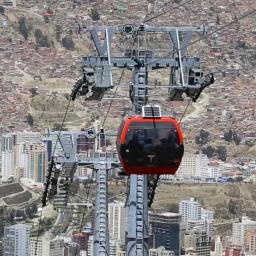How the Bolivian Capital of La Paz Successfully Implemented an Aerial Gondola Public Transit System

Sam Denby of Wendover Productions explained how La Paz, the capital city of Bolivia, uses aerial gondolas to transport their citizens across the steep and expansive terrain of the area. Similar to the ones used at ski resorts, these gondolas are suspended by cables.
This is La Paz the capital of Bolivia as far as capital cities go. It's fairly humble. Its population well under a million, is not huge. Its industrial and economic output is not massive, outpaced within Bolivia by Santa Cruz de la Sierra. And yet La Paz is home to this a robust interconnected reliable urban transit system that connects the core of the city to the far reaches of its sprawling outskirts
While it is not considered ideal public transportation in the way of buses or trains, La Paz's gondola system assists with busy commuting times.
Of course gondolas are not perfect as public transit after all they weren't designed for it just like at 9:00 a.m on a powder day at a ski area. Mi Teleferico experiences big lines during peak commuting hours due to the network's lack of surge capacity. A train or a bus line can simply schedule more vehicles during peak hours but across La Paz's 31 stops a 10-person gondola cabin is bound to head out every 12 seconds but never any quicker.
This system has been years in the making, as La Paz did not have much in the way of public transportation until an economic boom and new leadership that recognized that public transportation was important to the working class and indigenous people of Bolivia's capital city.
When comparing a gondola with a train it's worse in just about every way. But cost matters a whole lot in transit development especially in a place like La Paz, establishing some sort of public transit system has been a point of discussion in Bolivia's capital since the 1970s in the 80s. ...an economic boom coincided with the presidency of the brash socialist Evo Morales of indigenous descent himself. Morales recognized public transportation in the nation's capital as a popular opportunity for government investment a means to recognize Bolivia's nationalized and burgeoning gas export economy through a public project that would help all, but particularly the working class and indigenous majority commuters.
View this post on Instagram
View this post on Instagram